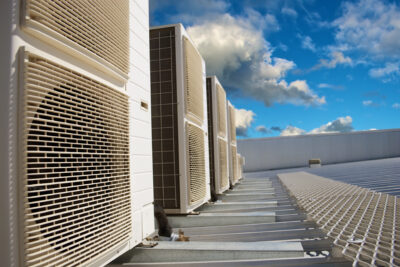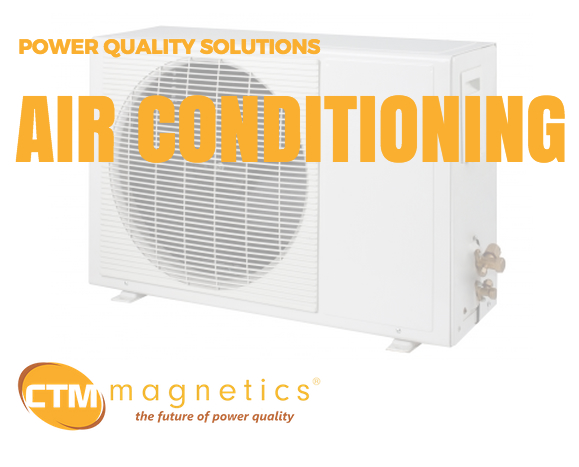Power Quality Solutions: HVAC
When it comes to driving and controlling motors used in air conditioning and chilling equipment, a device is needed to deliver clean power to the motors so that starts, stops and continuous running all take place without damage to the motors or the equipment.
Picture a motor running an A/C within a commercial building. Generally, it will have a cooling tower on the roof that has one or more fans, each driven by motors. The purpose of the cooling tower is to regulate the temperature of the air conditioner's condenser coils. When the cooling tower receives a signal that condensing coils are too hot, it's time to turn on the motors and run the fans. But unlike a home air conditioner that is either on or off, commercial units use three-phase motors with speed control. For example, it could be advantageous to run the fan at, say, 50% of its maximum speed to keep the temperature within desired limits.
Variable Frequency Drives (VFDs) allow for control of motor speed (as well as torque and other factors). VFDs are composed of two main components: a rectifier and an inverter. The rectifier converts AC power provided by grid into a DC bus voltage. The inverter transforms this DC bus back into AC power. While these multiple transformations might seem circuitous, the following characteristics justify the process:
[caption id="attachment_5058" align="alignleft" width="400"] HVAC units on a metal industrial roof in the afternoon[/caption]
HVAC units on a metal industrial roof in the afternoon[/caption]
Frequency Control
The VFD can supply AC power at a variety of frequencies, whereas the power grid operates at a constant frequency (50 or 60 hz, depending on location). An AC motor’s speed is linearly proportional to the supplied frequency. Powering a motor with current at higher frequencies allows it to spin faster, while lower frequencies result in slower rotation. Thus, the primary role of the VFD (as its name implies), is to deliver power over a range of frequencies, providing motor speed control. Automatically adjusting frequency allows the fans to continue running slowly when demand for air conditioning is low, say at night, then to increase frequency and fan speed during the heat of the day.
Voltage Control
The VFD can adjust the voltage magnitude of the inverter’s output to the motor. Fluctuating the VFD’s output voltage allows for variable torque operation. Variable torque is an especially useful capability with fluctuating loads and changing fan speeds, as speeding up and slowing down require torque modifications.
Soft Start and Stop Programming
The VFD can be programmed to protect the fan motor and the fans from damage by allowing for gradual ramp up and shutdown of the motor. For instance, if the motor is entirely off, immediately turning it on to full speed causes excessive current flow which could produce more torque than the motor and mechanical assemblies (gear boxes, bearings, etc.) are designed to withstand. Instead, the VFD can ramp the motor from zero RPM to the desired level over a period of several seconds to avoid damage. A VFD performs the same function when the fan is powered down; it decelerates the fan over a period of time so there is no mechanical shock or electrical damage. Finally, should the motor need to run in their reverse direction, a VFD can control the motor's direction of spin. Without a VFD there would be no practical way to reverse motor direction short of rewiring power to the motor.
Energy Considerations
While there are inherent power losses in the AC to DC to AC conversion process, VFDs provide energy savings through variable speed control. Rather than operating in simple on or off mode, the VFD enables variable speed air conditioning. This variable speed operation drastically lowers the amount of electricity used by the motor in partial load conditions. The U.S. Department of Energy estimates that American industry makes use of some 40 million motors, which account for around 70 percent of the nation's energy consumption. By adopting VFD's, the Department estimates that up to 18 percent of that energy could be saved.
Additional Protection
VFDs can lead to better energy efficiency, but sometimes harmonic distortion can occur that can damage any electronic equipment that shares the AC power. CTM Magnetics delivers line/load reactors to protect from such damage, mitigating harmonic distortion. These reactors provide an economic advantage by removing harmonic distortion and protecting sensitive electronic equipment. However, harmonic distortion can also have an adverse affect on power grids. Line/load reactors such as the ones developed by CTM can meet the standard (IEEE 519) that limits harmonic distortion on power grids, but to accurately filter power and create power quality, active front-end filters are needed.
The inverter section of the VFD also introduces significant harmonics on the motor. Induction motors require a sine waveform for efficient operation. Any harmonic variation from a perfect sine wave be dissipated in the motor heat. This power loss causes additional motor stress and decreased efficiency. Motor stress caused by harmonics is especially harmful for permanent magnet (PM) motors, which have an always on rotor magnetic field. By installing CTM line frequency or high frequency sinewave filters, inverter created harmonics can be filtered, leaving a near perfect sinusoidal waveform, reducing motor stress and inefficiency. As the leader in power quality solutions, CTM offers comprehensive solutions for clean, lasting power.
 " alt="">
" alt="">